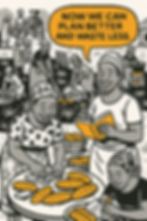How We Helped Cassava Farmers and Processors Waste Less, Earn More, and Build Resilient Markets in Isi-Emure

Project Overview
Role:
Service Designer (Research, Systems Mapping, Facilitation, Business Modeling)
Timeline :
2023– 2024
Objective:
To prototype a sustainable model for cassava-based food production that enhances livelihoods,regenerates ecosystems, and ensures long-term economic stability.
Target Audience:
Smallholder cassava farmers,local processors, and vendors in Ekiti, Nigeria.
Problem Statement
Despite being the backbone of Nigeria’s food system,cassava farmers and processors face systemic challenges: limited access to funding, unstable incomes, environmental degradation, high processing costs, and market vulnerability. Addressing these issues in isolation often worsened other parts of the system, revealing the critical need for an integrated, sustainable approach.
Research
To uncover the root causes of fragility in the cassava value chain, I employed a mixed-methods approach including ethnographic field studies, semi-structured interviews, and direct observation to understand lived experiences. I then synthesized these insights using causal loop diagrams and stakeholder analysis to map the systemic relationships and identify key leverage points.
Key Finding:
Market vulnerability deepened poverty.
Poverty, in turn, drove environmental degradation.
Financial exclusion and high capital costs hinder sustainable practices.
Institutional gaps (weak infrastructure, lack of support) exacerbated these inefficiencies.
These insights proved that the solution needed to be a holistic system redesign,not a standalone intervention.
Design Process
Starting with causal loop diagrams and stakeholder maps, we visualized the systemic barriers and identified key leverage points for intervention. Through iterative co-creation workshops, we refined the concept into a decentralized service ecosystem. Each stage was validated with community feedback, ensuring our solutions directly addressed the root causes of poverty, market vulnerability, and environmental degradation.

Here is the link to the interactive Abstract Map that summarize the Casual Loop Diagram:
Here is the link to the interactive Casual Loop Diagram:
Prototyping and Iteration
Our initial service prototype, modeled on the Business Model Canvas, underwent several iterations based on feedback from co-creation workshops. Early concepts highlighted confusion around financial access and market connections, leading us to simplify the system into a decentralized, community-owned network.

Testing and Feedback
Methods:
Iterative refinement of the Business Model Canvas with community feedback.
Key Findings:
Users deeply valued shared infrastructure and transparent market access, and strongly preferred SMS/USSD tools for their simplicity.
Iterations:
We adjusted system components and stakeholder incentives based on this feedback. The final service prototype incorporated lease-to-own models and an SMS/USSD vendor tool—solutions stakeholders found significantly more viable and empowering.

Outcome
The project resulted in a proven prototype for a decentralized service system that includes:
Lease-to-own clean energy kits for processors.
A WhatsApp/SMS/USSD-enabled vendor network for distribution.
New revenue streams from waste monetization for farmers.
Shared infrastructure models.
Impact
This work demonstrated a viable pathway to strengthening rural economies,reducing environmental degradation, and ensuring more resilient livelihoods by directly tackling the root causes of market vulnerability and financial exclusion.


User Feedback
Reflection
This project reinforced that sustainable impact requires aligning user needs with systemic change and viable business models.Deep community involvement was non-negotiable for creating a relevant and adopted solution. For the future, I would involve institutional stakeholders (e.g., banks, government agencies) earlier to better understand policy-level constraints and opportunities for scaling the model.